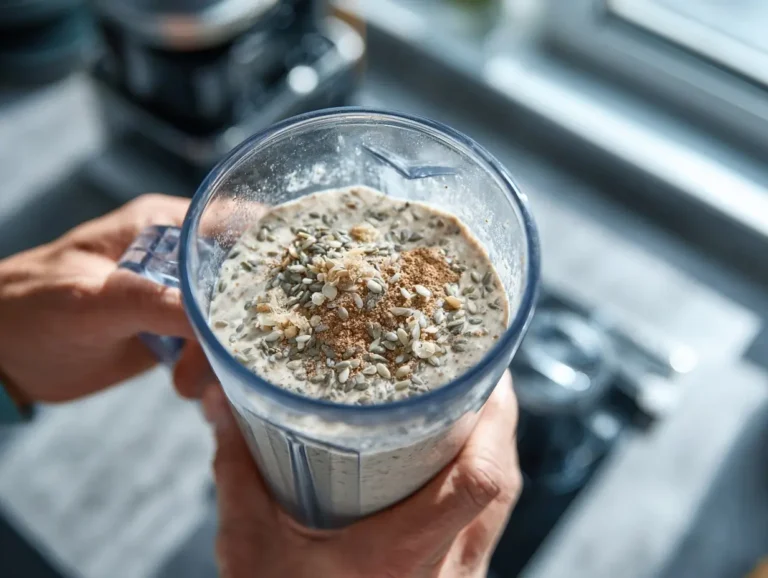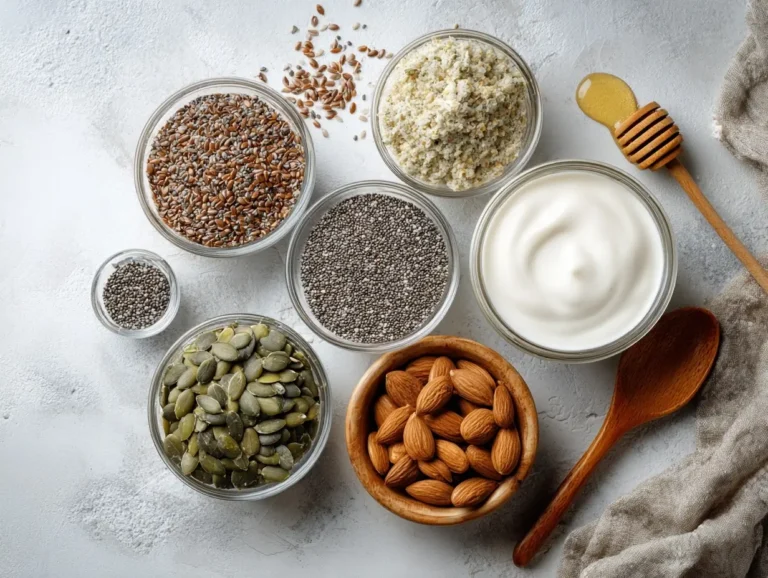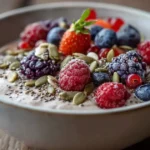Growing up, I loved experimenting in the kitchen with my grandmother. She always had a tin of sunflower and pumpkin seeds on the counter, and we’d snack on them while cooking. Years later, after my bariatric surgery, I found myself craving those same nutty, satisfying bites—but this time, my body needed something more nourishing and carefully balanced. That’s when I started making my very own bariatric seed recipe, a mix of protein-packed seeds blended with smooth yogurt and light spices. It turned into a staple during my recovery, providing not only comfort but also a serious boost of nutrients my body needed.
I remember one particular morning when nothing seemed to sit right—soups felt heavy, shakes were bland. I tossed chia, hemp, and flax seeds into my blender with a dollop of Greek yogurt and a drizzle of honey. That first spoonful was a revelation: creamy, crunchy, and energizing. Over time, I perfected this recipe, making it light enough for post-op diets while still keeping it flavorful. Friends recovering from bariatric surgery started asking for it, and soon it became a kitchen tradition we all loved sharing.
If you’ve been looking for a way to enjoy seeds after bariatric surgery without discomfort, this recipe is exactly what you need. It’s gentle on your stomach, easy to digest, and packed with the protein and fiber your body craves. Plus, it’s customizable—add a touch of cinnamon, a spoon of almond butter, or even some probiotic-rich kefir for an extra health boost. Whether you’re just starting your post-op journey or years into it, this bariatric seed recipe will quickly become a comforting, go-to snack or light meal.
Table of Contents
The Benefits of Seeds for Bariatric Nutrition
Power-Packed Protein and Fiber

Seeds like chia, hemp, flax, and sunflower aren’t just small—they’re nutritional powerhouses. They’re loaded with plant-based protein, which supports healing and maintains muscle mass after surgery. Fiber in these seeds also helps regulate digestion, which is often sensitive after bariatric procedures. The right blend of seeds can keep you feeling satisfied without overwhelming your stomach, making them ideal for post-op meals.
Essential Vitamins and Healthy Fats
Besides protein and fiber, seeds bring vital micronutrients like magnesium, zinc, and vitamin E into your diet. Healthy fats from flax and pumpkin seeds provide omega-3s that fight inflammation and support heart health. This is especially important when your new diet is limited in quantity—you want every bite to deliver maximum nutrition.
I’ll share exactly how to balance these seeds into a creamy, bariatric-friendly recipe that’s not just nutritious but genuinely tasty. It’s been a lifesaver for me and many in our support community, becoming as comforting as a warm cup of tea on a cold morning.
Creating the Perfect Bariatric Seed Recipe
| Ingredient | Amount |
|---|---|
| Chia seeds | 2 tbsp |
| Ground flaxseed | 1 tbsp |
| Hemp seeds | 1 tbsp |
| Crushed pumpkin seeds | 1 tsp |
When making a bariatric seed recipe, the right seed blend makes all the difference for post-op digestion. Through experimentation, I discovered a mix that works beautifully: chia, hemp, ground flax, and pumpkin seeds. This seed recipe for bariatric diets offers protein, fiber, and healthy fats while staying gentle on sensitive stomachs.
Choosing and Preparing Seeds for Bariatric Nutrition
For a successful bariatric seed recipe, proper seed preparation is key. Chia and flax seeds must be soaked overnight to form a gel-like texture that aids digestion. Hemp seeds, naturally soft, add creaminess without extra prep. Pumpkin seeds are lightly toasted and crushed, adding flavor and crunch without heaviness. A ratio of 2 tablespoons chia, 1 tablespoon each flax and hemp, and a teaspoon pumpkin seeds creates a balanced bariatric-friendly seed recipe.
Before soaking, I toast pumpkin seeds to enhance their aroma and make them easier to digest. Chia and flax seeds absorb liquid, so soaking them in almond milk overnight ensures a soft, nutrient-rich base—perfect for a post-op bariatric seed pudding.
Blending for Smooth and Nutritious Results
Once soaked, the seeds create a pudding-like base ideal for bariatric seed recipes. Blending them with Greek yogurt, a touch of cinnamon, and honey yields a creamy, lightly sweetened meal that’s easy to eat. For extra protein, a scoop of plant-based powder blends seamlessly.
For savory variations, skip the honey and add fresh herbs or lemon zest. This version pairs well with light meals, making it a versatile bariatric seed meal for any time of day.
Tip: Pair this bariatric seed recipe with my lemon olive oil elixir or natural mounjaro tea for a nutrient-packed recovery plan.
Delicious Variations of the Bariatric Seed Recipe

One of the best things about this bariatric seed recipe is how easy it is to customize. After surgery, your taste buds and tolerance levels might change, so having versatile options keeps meals exciting without risking discomfort. Here are my favorite variations that stay gentle on your stomach while adding flavor and nutrition.
Sweet Bariatric Seed Pudding
For a dessert-like treat, blend the soaked seeds with a dash of vanilla extract, cinnamon, and a teaspoon of sugar-free maple syrup. Top with mashed berries for a burst of antioxidants. This sweet version feels like a comforting pudding but is light enough for post-op recovery. It’s a perfect evening snack that won’t overload your stomach while still hitting your bariatric seed recipe goals.
Savory Protein Seed Bowl
Transform the same base into a savory dish by mixing in soft avocado, a sprinkle of nutritional yeast, and finely chopped spinach. This option creates a creamy, nutrient-dense bariatric seed meal that’s rich in protein and healthy fats. I often serve it alongside grilled chicken or fish for a balanced lunch.
If you want to complement this meal with other detox-friendly options, check out my blue tonic weight loss recipe or green tea drink recipe. These light beverages pair beautifully with a seed bowl, making them great companions for bariatric meal plans.
Portable Bariatric Seed Snack Bars
For busy days, I make small, no-bake bars using ground seeds, almond butter, and sugar-free syrup. Pressed into a tray and chilled, these become convenient snacks that fit your bariatric-friendly seed recipe needs. They’re easy to carry and digest, giving you energy without a sugar crash.
Fruit-Infused Bariatric Seed Recipe
Adding soft, diced fruits like papaya or kiwi brings natural sweetness and extra fiber. Combined with the soaked seeds, it becomes a refreshing breakfast bowl that’s light but filling. This is my go-to option on warm mornings when I need hydration and gentle nutrition in one bowl.
Long-Term Benefits of the Bariatric Seed Recipe
As I settled into my new lifestyle after surgery, I realized that sticking to a bariatric seed recipe wasn’t just about early recovery—it became an essential part of my long-term health journey. Seeds provide sustained energy, support weight management, and help maintain muscle mass, which is crucial after bariatric procedures.
Supporting Digestive Health Post-Surgery
A good bariatric seed recipe is packed with soluble fiber that gently regulates digestion without causing bloating. Chia and flax seeds form a gel-like texture that soothes your gut while promoting nutrient absorption. This helps keep your digestion smooth, even as you adapt to smaller meal sizes.
Helping Maintain Weight Loss and Nutrient Intake
Protein and omega-3 fats from seeds help you stay full longer and curb unhealthy cravings. Regularly enjoying this bariatric-friendly seed meal ensures you’re getting vitamins and minerals that sometimes become challenging to absorb after surgery. Over the years, I’ve noticed that my energy levels and hair health improved significantly once I made seeds a daily staple.
Incorporating this recipe with options like my berberine weight loss guide or apple cider vinegar detox creates a powerful, balanced post-op diet plan.
Conclusion
Creating a bariatric seed recipe doesn’t have to be complicated. With a few nutrient-packed seeds and a little preparation, you can enjoy a high-protein, gentle, and flavorful meal perfect for every stage of your bariatric journey. Whether you’re blending a creamy pudding, shaping snack bars, or topping a breakfast bowl with fruits, these seeds provide the nourishment you need for recovery and long-term success.
If you love discovering new healthy recipes and creative meal ideas, follow us on Pinterest where we share daily inspiration for bariatric-friendly meals and weight loss tips.
FAQs about Bariatric Seed Recipes
What are the best seeds to include in a bariatric seed recipe for weight loss?
Chia, hemp, flax, and pumpkin seeds are ideal because they’re rich in protein and healthy fats while remaining gentle on digestion.
How do seeds help digestion after bariatric surgery?
Their soluble fiber softens and absorbs water, forming a gel that makes digestion smoother and helps regulate bowel movements without strain.
Can I make a high-protein bariatric seed recipe for breakfast?
Yes, blending soaked seeds with Greek yogurt or adding protein powder creates a filling, high-protein meal perfect for mornings.
Are bariatric seed recipes safe for post-op gastric sleeve or bypass diets?
Absolutely. When soaked and blended correctly, they’re soft, easy to chew, and nutrient-dense, making them safe and beneficial for both gastric sleeve and bypass patients.

Bariatric Seed Recipe
- Total Time: 5 minutes
- Yield: 2 servings 1x
Description
A nutritious, high-protein bariatric seed recipe with chia, flax, hemp, and pumpkin seeds blended for easy digestion.
Ingredients
2 tbsp chia seeds
1 tbsp ground flaxseed
1 tbsp hemp seeds
1 tsp crushed pumpkin seeds
½ cup unsweetened almond milk
1 tbsp Greek yogurt
1 tsp honey
Pinch cinnamon
Instructions
Step 1: Soak chia and flax seeds in almond milk overnight.

Step 2: Toast and crush pumpkin seeds lightly.
Step 3: Blend soaked seeds with yogurt, honey, and cinnamon.
Step 4: Top with crushed pumpkin seeds and serve chilled.
Notes
Optional: Add protein powder for an extra boost.
Adjust thickness by adding more or less almond milk.
- Prep Time: 5 minutes
- Cook Time: 0 minutes
- Category: Snack
- Method: No-cook
- Cuisine: Healthy
Nutrition
- Serving Size: 1/2 cup
- Calories: 150
- Sugar: 2g
- Sodium: 40mg
- Fat: 9g
- Saturated Fat: 1g
- Unsaturated Fat: 8g
- Trans Fat: 0g
- Carbohydrates: 10g
- Fiber: 6g
- Protein: 7g
- Cholesterol: 0mg

